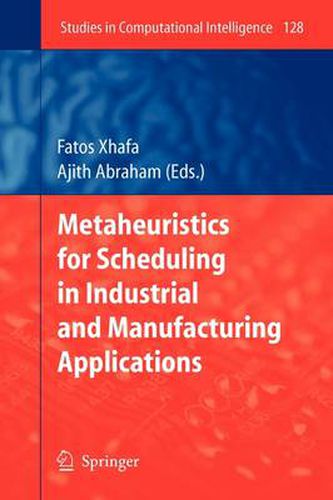Readings Newsletter
Become a Readings Member to make your shopping experience even easier.
Sign in or sign up for free!
You’re not far away from qualifying for FREE standard shipping within Australia
You’ve qualified for FREE standard shipping within Australia
The cart is loading…






This title is printed to order. This book may have been self-published. If so, we cannot guarantee the quality of the content. In the main most books will have gone through the editing process however some may not. We therefore suggest that you be aware of this before ordering this book. If in doubt check either the author or publisher’s details as we are unable to accept any returns unless they are faulty. Please contact us if you have any questions.
During the past decades scheduling has been among the most studied op- mization problemsanditisstillanactiveareaofresearch!Schedulingappears in many areas of science, engineering and industry and takes di?erent forms depending on the restrictions and optimization criteria of the operating en- ronments [8]. For instance, in optimization and computer science, scheduling has been de?ned as the allocation of tasks to resources over time in order to achieve optimality in one or more objective criteria in an e?cient way and in production as production schedule, i. e. , the planning of the production or the sequence of operations according to which jobs pass through machines and is optimal with respect to certain optimization criteria.
Although there is a standardized form of stating any scheduling problem, namely e?cient allocation ofn jobs onm machines -which can process no more than one activity at a time- with the objective to optimize some - jective function of the job completion times , scheduling is in fact a family of problems. Indeed, several parameters intervene in the problem de?nition: (a) job characteristics (preemptive or not, precedence constraints, release dates, etc. ); (b) resource environment (single vs. parallel machines, un- lated machines, identical or uniform machines, etc. ); © optimization criteria (minimize total tardiness, the number of late jobs, makespan, ?owtime, etc. ; maximize resource utilization, etc. ); and, (d) scheduling environment (static vs. dynamic,intheformerthenumberofjobstobeconsideredandtheirready times are available while in the later the number of jobs and their charact- istics change over time).
$9.00 standard shipping within Australia
FREE standard shipping within Australia for orders over $100.00
Express & International shipping calculated at checkout
This title is printed to order. This book may have been self-published. If so, we cannot guarantee the quality of the content. In the main most books will have gone through the editing process however some may not. We therefore suggest that you be aware of this before ordering this book. If in doubt check either the author or publisher’s details as we are unable to accept any returns unless they are faulty. Please contact us if you have any questions.
During the past decades scheduling has been among the most studied op- mization problemsanditisstillanactiveareaofresearch!Schedulingappears in many areas of science, engineering and industry and takes di?erent forms depending on the restrictions and optimization criteria of the operating en- ronments [8]. For instance, in optimization and computer science, scheduling has been de?ned as the allocation of tasks to resources over time in order to achieve optimality in one or more objective criteria in an e?cient way and in production as production schedule, i. e. , the planning of the production or the sequence of operations according to which jobs pass through machines and is optimal with respect to certain optimization criteria.
Although there is a standardized form of stating any scheduling problem, namely e?cient allocation ofn jobs onm machines -which can process no more than one activity at a time- with the objective to optimize some - jective function of the job completion times , scheduling is in fact a family of problems. Indeed, several parameters intervene in the problem de?nition: (a) job characteristics (preemptive or not, precedence constraints, release dates, etc. ); (b) resource environment (single vs. parallel machines, un- lated machines, identical or uniform machines, etc. ); © optimization criteria (minimize total tardiness, the number of late jobs, makespan, ?owtime, etc. ; maximize resource utilization, etc. ); and, (d) scheduling environment (static vs. dynamic,intheformerthenumberofjobstobeconsideredandtheirready times are available while in the later the number of jobs and their charact- istics change over time).